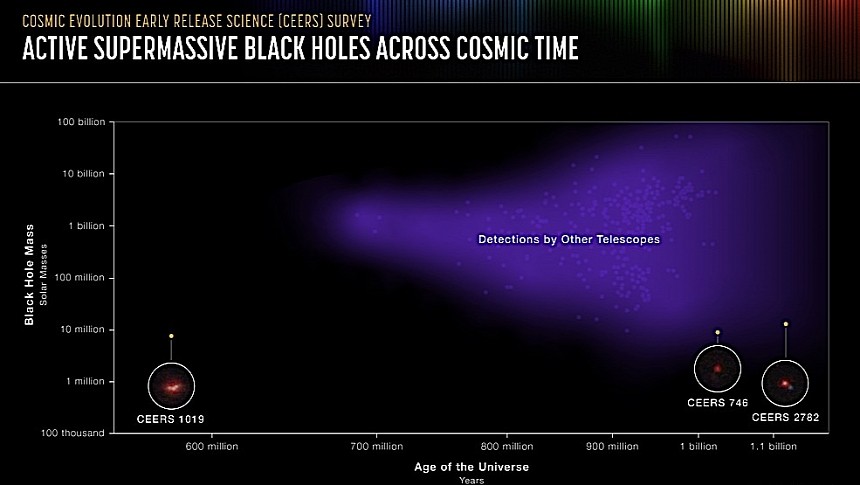It was clear from the get-go that the $10 billion James Webb Space Telescope (JWST) would go down in history as the most capable tool of its kind humanity has birthed to date. But ever since it actually got to space to spy on the Universe, it even managed to surprise the most optimistic of us.
Webb's latest shenanigan involves the discovery of the oldest supermassive black hole that we know of. As it looks back in time into the far reaches of space, the telescope managed to catch glimpses of a black hole dating back to just 570 million years after the Big Bang. That's more than 13 billion years ago, if you want to split hairs.
Being so old means the black hole is very far away from us, so far away that NASA officially calls it the "most distant active supermassive black hole" discovered to date.
Located in a galaxy called CEERS 1019, the black hole is also less massive than formations of its kind dating back to the early Universe. Weighing "just” nine million solar masses, it's twice the size of the black hole located at the center of our own Milky Way. By comparison, other such galactic monsters tip the scales at a staggering one billion times the mass of the Sun that lights up our days.
Because it's so small and so far away, CEERS 1019's black hole would have been almost impossible to detect without the help of a telescope as capable as Webb, for the simple reason that they were too faint to detect by other means. In fact, the space tool is so capable that astronomers believe CEERS 1019 won't hold the title for most distant active supermassive black hole for long – not one, but several new ones might claim the title within weeks.
The rapid rate at which Webb uncovers black holes is owed to something called the Cosmic Evolution Early Release Science (CEERS) Survey, ran by a team from the University of Texas at Austin. The main goal of the research is not only to confirm the existence of smaller black holes believed to have been born when the Universe was still young (between 470 and 675 million years after the Big Bang), but also shine new light on them.
To date, the CEERS survey has revealed eleven galaxies from the timeframe, but a lot more is left to explore, NASA says. It is of course too early to say what Webb will uncover next, but the world is clearly watching because, as complicated as these things seem to be, they might just help answer some of humanity's most pressing matters.
We'll keep an eye out for the telescope's next adventures and of course bring before you its most extraordinary findings.
Being so old means the black hole is very far away from us, so far away that NASA officially calls it the "most distant active supermassive black hole" discovered to date.
Located in a galaxy called CEERS 1019, the black hole is also less massive than formations of its kind dating back to the early Universe. Weighing "just” nine million solar masses, it's twice the size of the black hole located at the center of our own Milky Way. By comparison, other such galactic monsters tip the scales at a staggering one billion times the mass of the Sun that lights up our days.
Because it's so small and so far away, CEERS 1019's black hole would have been almost impossible to detect without the help of a telescope as capable as Webb, for the simple reason that they were too faint to detect by other means. In fact, the space tool is so capable that astronomers believe CEERS 1019 won't hold the title for most distant active supermassive black hole for long – not one, but several new ones might claim the title within weeks.
The rapid rate at which Webb uncovers black holes is owed to something called the Cosmic Evolution Early Release Science (CEERS) Survey, ran by a team from the University of Texas at Austin. The main goal of the research is not only to confirm the existence of smaller black holes believed to have been born when the Universe was still young (between 470 and 675 million years after the Big Bang), but also shine new light on them.
To date, the CEERS survey has revealed eleven galaxies from the timeframe, but a lot more is left to explore, NASA says. It is of course too early to say what Webb will uncover next, but the world is clearly watching because, as complicated as these things seem to be, they might just help answer some of humanity's most pressing matters.
We'll keep an eye out for the telescope's next adventures and of course bring before you its most extraordinary findings.









